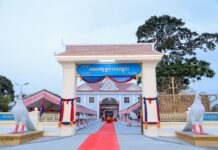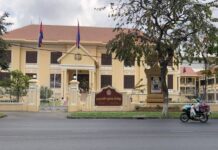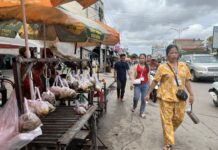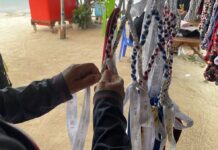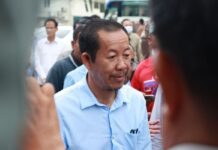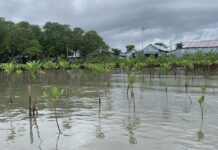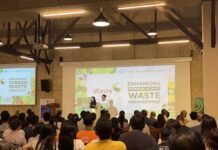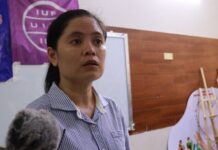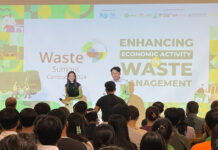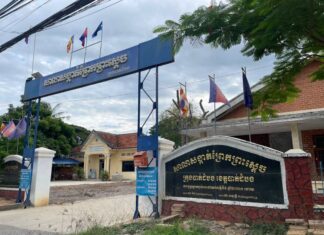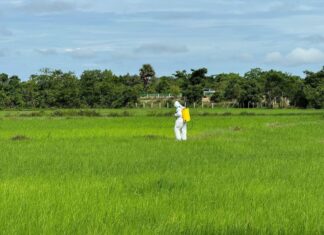Home Blog
ក្រសួងមួយចំនួនបង្ហោះសកម្មភាពចុះជួយបក្សប្រជាជនកម្ពុជាលើហ្វេសប៊ុកផ្លូវការរបស់ខ្លួន
នៅមុនពេលការបោះឆ្នោតជ្រើសតាំងតំណាងរាស្រ្តអាណត្តិទី៧ ខែកក្កដា ឆ្នាំ២០២៣ កាន់តែជិតចូលមកដល់ គេសង្កេតឃើញថា ក្រសួង ស្ថាប័នខ្លះដែលជាសេនាធិការរបស់រាជរដ្ឋាភិបាល ក្រោមការដឹកនាំរបស់គណបក្សប្រជាជនកម្ពុជា បានបង្ហោះពីសកម្មភាពចុះមូលដ្ឋាន និងខ្លឹមសារនានា នៅលើទំព័រហ្វេសប៊ុកផ្លូវការរបស់ខ្លួន ដែលបង្ហាញពីសមិទ្ធផលរបស់គណបក្សកាន់អំណាច និងបានអំពាវនាវឱ្យប្រជាពលរដ្ឋបោះឆ្នោតឱ្យគណបក្សប្រជាជនកម្ពុជា។
Push for Economic Progress Risks Leaving Underage Workers Behind
Despite remarkable economic achievements — the Kingdom is on track to exit LDC status in 2029 — a yawning gap between the rich and poor remains, with the young and urban poor shouldering much of the burden.
សង្គមស៊ីវិលស្នើរដ្ឋាភិបាលឱ្យបង្កើនថវិកាសម្រាប់ថ្នាក់ក្រោមជាតិចំនួន៣០%នៃថវិកាជាតិសរុប
ក្រុមអង្គការសង្គមស៊ីវិលអះអាងថា ការកើនឡើងនៃថវិកាថ្នាក់ក្រោមជាតិនៅតែមានចំនួនតិចនៅឡើយ បើធៀបជាមួយនឹងស្តង់ដារនៃការប្រើប្រាស់ថវិកាដោយទទូចស្នើឱ្យរដ្ឋាភិបាលគួរតែរៀបចំថវិកាថ្នាក់ក្រោមជាតិប្រហែលជា៣០% នៃថវិកាសរុបរបស់ជាតិ។
នាយកប្រតិបត្តិអង្គការតម្លាភាពកម្ពុជា លោក ប៉ិច ពិសី យល់ថាការកើនឡើងនៃថវិកាថ្នាក់ក្រោមជាតិ នៅតែមានចំនួនតិចនៅឡើយបើធៀបជាមួយនឹងស្តង់ដារនៃការប្រើប្រាស់ថវិកា ហើយរដ្ឋាភិបាលគួរតែ រៀបចំថវិកាថ្នាក់ក្រោមជាតិប្រហែលជា៣០% នៃថវិកាសរុបរបស់ជាតិ។
លោកបន្តថា៖ «បើយើងមានលទ្ធភាពគួរតែបង្កើននូវទំហំថវិកាទៅថ្នាក់ក្រោមជាតិហ្នឹងឱ្យច្រើនជាង ហ្នឹងបើអាចចន្លោះពី២០% ទៅ៣០% (នៃថវិកាសរុប) ការធានានូវតម្លាភាព គណនេយ្យភាពហើយការចាយថវិកាដោយមិនមានការកេងប្រវ័ញ្ច ហើយអំពើពុករលួយ»។
ប្រភពដដែលបានអះអាងថា បើទោះបីជាថវិកាថ្នាក់ក្រោមជាតិមានចំនួនមិនច្រើនក៏ដោយ តែក៏អាចយក មកប្រើប្រាស់ក្នុងការអភិវឌ្ឍភូមិ ឃុំមួយចំនួនបានគ្រប់គ្រាន់ ប្រសិនបើការចំណាយថវិកាប្រកបដោយ...
ក្រសួងកសិកម្មអនុម័តថវិកាជាង៧០%នៃថវិកាសរុបទៅលើការគ្រប់គ្រងស្ថាប័ន ខណៈការបង្កើនដំណាំកសិកម្មមានតែ១៤%
ក្រសួងកសិកម្ម រុក្ខាប្រម៉ាញ់ និងនេសាទសម្រេចអនុម័តកញ្ចប់ថវិកាក្នុងឆ្នាំ២០២៤ ប្រមាណជាង៧០% នៃថវិកាសរុបទៅលើកម្មវិធីទី៥ ការគ្រប់គ្រងស្ថាប័ន និងការអភិវឌ្ឍធនធានមនុស្ស ខណៈថវិកា ១៤% បានបែងចែកទៅកម្មវិធីទី១ ការបង្កើនផលិតភាពដំណាំកសិកម្ម ការជំរុញផលិតកម្មដំណាំកសិកម្ម និងកសិធុរកិច្ច។
អ្នកនាំពាក្យក្រសួងកសិកម្ម រុក្ខាប្រម៉ាញ់ និងនេសាទ លោក ឃឹម ហ្វីណង់ មានប្រសាសន៍ថា ការបែងចែកថវិកាក្នុងកម្មវិធីនីមួយៗគឺជាការបែងចែកមួយយ៉ាងច្បាស់លាស់ និងសមស្របទៅតាមគោលដៅរបស់ក្រសួង ជាពិសេសក្រសួងកសិកម្មបានបែងចែកការចំណាយប្រមាណជាង ៥០% ទៅលើការងារកសិកម្ម...
ថវិកាវិស័យអប់រំកើនឡើង ប៉ុន្ដែបញ្ហាខ្វះខាតមួយចំនួននៅមិនទាន់ដោះស្រាយ
ថវិកាវិស័យអប់រំមានការកើនឡើងជាបន្តបន្ទាប់សម្រាប់ចំណាយទៅការអភិវឌ្ឍវិស័យអប់រំនៅកម្ពុជាលើកលែងតែក្នុងឆ្នាំ២០២១ និង២០២២ ថវិកាចំណាយមានការថយចុះដោយសារតែបញ្ហាកូវីដ១៩ ដែលថវិកាមួយផ្នែកត្រូវបង្វិលទៅវិស័យសុខាភិបាលនាពេលនោះ។
បើតាមច្បាប់ស្តីពីហិរញ្ញវត្ថុសម្រាប់ការគ្រប់គ្រង នៅឆ្នាំ២០២៣ ស្ថានភាពកូវីដ១៩ នៅកម្ពុជាមានភាពធូរស្បើយខណៈថវិកាសម្រាប់វិស័យអប់រំមានការកើនឡើងដែលមានទឹកប្រាក់ប្រហាក់ប្រហែលនឹងមុនពេលកូវីដ១៩។ ពោលគឺកាលពីឆ្នាំ២០២០ ថវិកាវិស័យអប់រំមានទឹកប្រាក់ប្រមាណ ៩១៩ លានដុល្លារសហរដ្ឋអាមេរិក ហើយក្នុងឆ្នាំ២០២៣ ក្រសួងអប់រំទទួលបាន ថវិកា ប្រមាណ ៩១៧ លានដុល្លារសហរដ្ឋអាមេរិក។
ប្រភពដដែលបញ្ជាក់ថា ការកើនឡើងនៃថវិកាថ្នាក់ជាតិរបស់ក្រសួងអប់រំសម្រាប់ចំណាយទៅ លើការអភិវឌ្ឍវិស័យអប់រំនៅកម្ពុជាតាំងពីបឋមសិក្សា រហូតដល់ឧត្ដមសិក្សា និងការអប់រំជំនាញទន់ដល់យុវជនស្ដែងឡើងតាមរយៈកម្មវិធីអភិវឌ្ឍដែលក្រសួងរៀបចំឡើង និងមុខងារអប់រំ។
ប្រធានសមាគមគ្រូបង្រៀនកម្ពុជាឯករាជ្យ អ្នកស្រី អ៊ុក...
សង្គមស៊ីវិលជំរុញឱ្យក្រសួងសុខាភិបាលប្រើថវិកាឱ្យចំគោលដៅ ខណៈឆ្នាំ២០២៤ក្រសួងបានថវិកាតិចជាងឆ្នាំមុន ៦០លានដុល្លារ
សង្គមស៊ីវិលជំរុញឱ្យក្រសួងសុខាភិបាលប្រើប្រាស់ថវិកា និងធនធានដែលមានឱ្យចំគោលដៅ ខណៈក្រសួងទទួលបានថវិកាជាង ៤៣៨លានដុល្លារ សម្រាប់ចំណាយក្នុងឆ្នាំ២០២៤ ដែលចំនួននេះថយចុះជាង ៦០លានដុល្លារ បើធៀបនឹងឆ្នាំ២០២៣។
នាយកប្រតិបត្តិអង្គការតម្លាភាពកម្ពុជា លោក ប៉ិច ពិសី មានប្រសាសន៍ថា ថវិកាថ្នាក់ជាតិសម្រាប់ក្រសួងសុខាភិបាលឆ្នាំ២០២៤ ថយចុះព្រោះតែខ្ទង់ចំណូលថវិកាជាតិមានការថមថយ ហើយកម្ពុជាបានរើខ្លួនពីវិបត្តិជំងឺកូវីដ១៩ ដូច្នេះកម្ពុជាលែងត្រូវការថវិកាបម្រុងទុកច្រើនដើម្បីដោះស្រាយបញ្ហាកូវីដ១៩។
លោកបន្តថា ទំហំថវិកាប្រចាំឆ្នាំ២០២៤ សម្រាប់វិស័យសុខាភិបាលមិនថយចុះច្រើនទេ បើធៀបនឹងមុនពេលកូវីដ១៩។ ហើយក្រសួងសុខាភិបាលនៅតែអាចដោះស្រាយបញ្ហាផ្សេងៗ ក្នុងការអភិវឌ្ឍន៍វិស័យសុខាភិបាល បើសិនជាប្រើប្រាស់ថវិកាឱ្យចំគោលដៅ។
លោកបន្ថែមថា៖ «បើសិនជាយើងមានលុយតិច យើងចាយឱ្យត្រឹមត្រូវទៅ...
បទយកការណ៍៖កម្មករថាការដំឡើងប្រាក់ឈ្នួល៤ដុល្លារបន្ថែមឆ្នាំ២០២៥មិនអាចជួយឱ្យជីវភាពពួកគេប្រសើរ
សំឡេងឆ្នោតគាំទ្រតួលេខប្រាក់ឈ្នួល២០៦ដុល្លារអាមេរិកដែលលើកឡើងដោយនិយោជក បាននាំមុខគេដែលបញ្ហានេះ បានជំរុញឱ្យកម្មករនិយោជិតនឹងទទួលបានការដំឡើងប្រាក់ឈ្នួលផ្លូវការចំនួន២ដុល្លារបន្ថែមទៀត ពីភាគីនិយោជកនៅឆ្នាំ២០២៥ ហើយការដំឡើងនេះ បើធៀបនឹងតួលេខកាលពីឆ្នាំ២០២៤ គឺមានធំដូចគ្នា។
តាមរយៈការបោះឆ្នោត ដែលមានតំណាងសរុបចំនួន ៥១រូប ក្នុងនោះតំណាងមកពីសហជីព១៧រូប តំណាងនិយោជក១៧នាក់ និងតំណាងមកពីក្រសួងការងារ១៧រូប។ ការបោះឆ្នោតនេះ ធ្វើឡើងតាមរយៈកិច្ចប្រជុំចុងក្រោយ កាលពីរសៀលថ្ងៃទី១៩ ខែកញ្ញា ឆ្នាំ២០២៤។
លទ្ធផលបោះឆ្នោតបង្ហាញថា តួលេខប្រាក់ឈ្នួល ២០៦ដុល្លារក្នុងមួយខែ ដែលលើកឡើងដោយក្រុមនិយោជក ទទួលបានការគាំទ្រ៤៦សំឡេង។ ដោយឡែក តួលេខប្រាក់ឈ្នួល២១៤ដុល្លារ ទទួលបានការគាំទ្រចំនួន៤សំឡេង...
បទយកការណ៍៖ ជាងចម្លាក់ប្រាក់ស្ពាន់ រំលេចក្បាច់រចនានៃប្រាង្គប្រាសាទខ្មែរនៅលើវត្ថុប្រើប្រាស់ផ្សេងៗ
ខេត្តកណ្ដាល៖ សម្លេងដំខ្សាវៗលឺចេញពីរោងមួយដែលមានបុរសចំណាស់ម្នាក់ មានបង់ក្រមានៅក កំពុងអង្គុយលើកៅអីឈើ ដៃស្ដាំកាន់ញញួរ ដៃឆ្វេងកាន់ដែកដំ កំពុងឆ្លាក់ដងដាវដើម្បីឱ្យក្បាច់រចនាលេចចេញជារូបរាង។
លោក ជា យុទ្ធា ដែលមានសក់ស្កូវ ពាក់វែនតា វ័យ៧០ឆ្នាំរូបនេះ ប្រកបរបរជាជាងចម្លាក់ប្រាក់ស្ពាន់ ជិតពាក់កណ្ដាលជីវិតមកហើយ ដោយសារចិត្តស្រឡាញ់ការងារជាជាងចម្លាក់នេះ។ លោកបានផ្តើមប្រកបរបរនេះនៅផ្ទះរបស់ខ្លួន ហើយក្រោយមករបរនេះមានការរីកចម្រើន ដោយមានទទួលបណ្ដុះបណ្ដាលកូនជាងប្រហែលជាង១០នាក់មកហើយ។ ទីតាំងរោងជាងឈ្មោះ ‹‹Ramo-ជាងចម្លាក់››នេះស្ថិតនៅភូមិ សាលាកាត់សក់ ឃុំវិហារលួង ស្រុកពញ្ញាឮ ខេត្តកណ្ដាល។
ជាងចម្លាក់ប្រាក់ស្ពាន់...
បទយកការណ៍៖ អង្រឹងក្រណាត់ក្រងពីកាកសំណល់រោងចក្រកាត់ដេរជួយដល់បរិស្ថានមួយផ្នែក
កំពុងអង្គុយក្រងអង្រឹងក្រណាត់ដែលជាកាកសំណល់ចេញពីរោងចក្រ អ្នកស្រី សុខ ស្រីណាក់ អាយុ៤៤ឆ្នាំ ប្រកបរបរក្រងអង្រឹងនៅភូមិព្រៃខ្លា ឃុំជំរះពេន ស្រុកសំរោង ខេត្តតាកែវ ប្រមាណជា១៥ឆ្នាំមកហើយ។
ក្នុងកន្រ្ដកក្បែរអ្នកស្រីកំពុងអង្គុយក្រង មានគំនរក្រណាត់ចម្រុះពណ៌ច្រើនប្រភេទសម្រាប់ក្រងជាអង្រឹង ដូចជាសាច់ក្រណាត់ធម្មតា សាច់ពោះគោ សាច់ភួយ និងខ្សែស្លាកអាវ ឬខោជាដើម ជាក្រណាត់ដែលអ្នកស្រី សុខ ស្រីណាក់ ទិញពីអ្នកធ្វើការរោងចក្រ ហើយយកកំទេចក្រណាត់សល់ពីរោងចក្រមកលក់បន្ត។
សម្រាប់អ្នកប្រកបរបរក្រងអង្រឹងធ្វើពីកំទេចក្រណាត់រោងចក្រដូចជាអ្នកស្រី សុខ ស្រីណាក់ យល់ថា...
Cambodia’s Energy Crossroads: Solar capacity could grow sixfold by 2040
By Socheata Hean
Cambodia — In past decades, the family of Heur Sophy, 44, made their living with the flow of the seasons in the northern...
តុលាការដាក់វិធានមួយចំនួនលើលោក រ៉ុង ឈុន ក្រោយលោកចូលបំភ្លឺតាមដីកាកោះ
សាលាដំបូងរាជធានីភ្នំពេញ បានដាក់វិធានតុលាការចំនួន ៥ចំនុច ទៅលើ លោក រ៉ុង ឈុន ទីប្រឹក្សាគណបក្សកម្លាំងជាតិ ដូចជាតម្រូវឱ្យមានការអនុញ្ញាតចេញក្រៅប្រទេស ជូនដំណឹងករណីលោកប្ដូរទីលំនៅ និងហាមការជួបជុំជាដើម។
ការដាក់វិធាននេះ ធ្វើឡើងខណៈ លោក រ៉ុង ឈុន បានចូលបំភ្លឺនៅសាលាដំបូងរាជធានីភ្នំពេញ នៅថ្ងៃទី២០ ខែកញ្ញា ឆ្នាំ២០២៤ តាមដីកាកោះហៅរបស់ចៅក្រុមស៊ើបសួរ លោក ទិត សុទ្ធីបូរ៉ាឆាត ចុះថ្ងៃទី៤...
លីកាដូ៖ មនុស្សប្រមាណ៦០នាក់រងការចោទ និងកំពុងជាប់ឃុំក្នុងពន្ធនាគារពាក់ព័ន្ធគម្រោងCLV
អង្គការការពារសិទ្ធិមនុស្ស លីកាដូ(Licadho) រកឃើញថា មនុស្សប្រមាណ៦០នាក់ ត្រូវបានរងការចោទប្រកាន់ និងកំពុងជាប់ឃុំក្នុងពន្ធនាគារ ដោយសារការបង្ហោះសារលើបណ្តាញស ង្គម និងគម្រោងជួបជុំ ពាក់ព័ន្ធនឹងកិច្ចព្រមព្រៀងតំបន់ត្រីកោណអភិវឌ្ឍន៍ កម្ពុជា-ឡាវ-វៀតណាម (CLV-DTA) ក្នុងពេលកន្លងទៅនេះ។
របាយការណ៍របស់អង្គការលីកាដូ ដែលបានចេញផ្សាយកាលពីថ្ងៃទី១៦ ខែកញ្ញា បានឱ្យដឹងថា មនុស្សជាង១០០នាក់ត្រូវចាប់ខ្លួន ពាក់ព័ន្ធនឹងព្រឹត្តិការណ៍ CLV នៅចន្លោះខែកក្កដា និងខែសីហា ឆ្នាំ២០២៤។ប៉ុន្តមនុស្សមួយចំនួនក្នុងចំណោមនោះ ត្រូវដោះលែងវិញ ខណៈមនុស្សដែលសេសសល់ប្រមាណ៦០នាក់...
បទយកការណ៍៖ សហគមន៍នេសាទព្រែកត្នោត ជួយការពារនិរន្តរភាពព្រៃកោងកាង និងជីវៈចម្រុះ
កំពត៖ សំឡេងរលកទឹកសមុទ្រ អមជាមួយខ្យល់បកតិចៗ លោក អ៊ុក សុវណ្ណរិទ្ធ ប្រធានសហគមន៍នេសាទព្រែកត្នោត ដែលកំពុងអង្គុយក្នុងទីស្នាក់ការនៅខេត្តកំពត ឲ្យដឹងថា មុនពេលបង្កើតសហគមន៍នេះ ប្រជាពលរដ្ឋ ព្រមទាំងរូបលោកផ្ទាល់មិនមានការយល់ដឹងទំនាក់ទំនងរវាងព្រៃកោងកាង និងជីវៈចម្រុះនោះទេ។ លោក អ៊ុក សុវណ្ណរិទ្ធ សំដៅដល់ ផលប៉ះពាល់នៃការកាប់បំផ្លាញព្រៃកោងកាង និងសារៈសំខាន់នៃការការពារព្រៃកោងកាងសម្រាប់ជីវៈចម្រុះ។
មានសម្បុរខ្មៅស្រអែម អមជាមួយទឹកមុខយ៉ាងមាំ លោក អ៊ុក សុវណ្ណរិទ្ធថ្លែងថា៖ «ការបង្កើតសហគមន៍ដើម្បីការពារធនធានធម្មជាតិ...
បទយកការណ៍៖ វេទិកាពិភាក្សាបញ្ហាសំណល់ ជំរុញការកែច្នៃឡើងវិញនៅកម្ពុជា
ភ្នំពេញ៖ នៅក្នុងបរិវេណហ្វេកតូរីភ្នំពេញ(Factory Phnom Penh)តាមបណ្ដាយផ្លូវ៦០ ម៉ែត្រ ដែលមានមនុស្សកុះករគ្រប់វ័យ និងចម្រុះជាតិសាសន៍ជាង៥០០នាក់ ចូលរួមក្នុងវេទិកាពិភាក្សាបញ្ហាសំណល់ឬ Waste Summit Cambodia 2024 នៅក្នុងប្រទេសកម្ពុជា។
វេទិកាពិភាក្សាបញ្ហាសំណល់លើកទី៧នេះ ធ្វើឡើងកាលពីថ្ងៃទី៧ ខែកញ្ញា ឆ្នាំ២០២៤ ដើម្បីជំរុញការសន្ទនាប្រកបដោយនិរន្តរភាព និងជាវេទិកាមួយបង្កើនឱ្យមានភាពសហការរវាងអ្នកជំនាញបរិស្ថាន អ្នកវិនិយោគ សហគ្រិន តំណាងរដ្ឋាភិបាលនិងភាគីពាក់ព័ន្ធផ្សេងទៀត។
កញ្ញា នួន ម៉ូនីកា ដែលជាអ្នកគ្រប់គ្រងកម្មវិធីរបស់...
កញ្ញា ឈឹម ស៊ីថរ រក្សាជំហរបន្តទាមទាររកដំណោះស្រាយពីក្រុមហ៊ុនណាហ្កាវើលដ៍ ក្រោយជាប់ពន្ធនាគារអស់២ឆ្នាំ
ប្រធានសហជីពទ្រទ្រង់សិទ្ធិការងារបុគ្គលិកកម្មករខ្មែរនៃក្រុមហ៊ុនណាហ្កាវើលដ៏(LRSU) កញ្ញា ឈឹម ស៊ីថរ បានបង្ហាញឆន្ទៈក្នុងការជួយដល់សមាជិកសហជីពរបស់ខ្លួន ដើម្បីឱ្យមានដំណោះស្រាយចំពោះវិវាទការងារនៅក្រុមហ៊ុនណាហ្កាវើលដ៍ ក្រោយពីកញ្ញាបានអនុវត្តទោសចប់អស់រយៈពេល ២ឆ្នាំ ក្នុងពន្ធនាគារ ក្រោមបទចោទញុះញង់។
កញ្ញា ឈឹម ស៊ីថរ ត្រូវបានសមត្ថកិច្ចចាប់ខ្លួន កាលពីខែមករា ឆ្នាំ២០២២ ហើយបន្ទាប់ពីជាប់ឃុំខ្លួននៅ «មណ្ឌលអប់រំកែប្រែទី២» អស់រយៈពេល២ខែ កញ្ញាត្រូវបានតុលាការដោះលែងឱ្យនៅក្រៅឃុំបណ្ដោះអាសន្ន អំឡុងខែមីនា ឆ្នាំ២០២២។ ប៉ុន្តែកាលពីថ្ងៃទី២៦ ខែវិច្ឆិកា ឆ្នាំ២០២២...
ស៊ុយអែតប្រកាសបិទការិយាល័យទូតរបស់ខ្លួននៅកម្ពុជានៅបំណាច់ខែកញ្ញានេះ
រដ្ឋាភិបាលស៊ុយអែត ប្រកាសបិទការិយាល័យស្ថានទូតរបស់ខ្លួនប្រចាំកម្ពុជា នៅបំណាច់ខែកញ្ញានេះ ហើយទុកឱ្យស្ថានទូតស៊ុយអែតប្រចាំទីក្រុងបាងកកប្រទេសថៃ ឈរពីចំងាយជាតំណាងឱ្យប្រទេសស៊ុយអែតនៅកម្ពុជាវិញ។
យ៉ាងណា រដ្ឋាភិបាលប្រទេសនេះមិនបានបញ្ជាក់ពីមូលហេតុជាក់លាក់នៃការបិទនេះទេ ដោយគ្រាន់តែលើកឡើងថា ការសម្រេចបិទនេះ ដោយសារតែរដ្ឋាភិបាលស៊ុយអែត បានបញ្ចប់កិច្ចសហប្រតិបត្តិការអភិវឌ្ឍន៍ទ្វេភាគីជាមួយប្រទេសកម្ពុជា។នេះបើតាមការប្រកាសនៅលើគេហទំព័រហ្វេសប៊ុកផ្លូវការរបស់ស្ថានទូតស៊ុយអែតដែលមានការិយាល័យប្រចាំទីក្រុងភ្នំពេញ នៅថ្ងៃទី១៦ ខែកញ្ញា ឆ្នាំ២០២៤នេះ។
ប្រភពបន្តថា៖«ស្ថានទូតស៊ុយអែតការិយាល័យប្រចាំទីក្រុងភ្នំពេញ នឹងត្រូវបិទជាផ្លូវការ និងឈប់ធ្វើការ ពីថ្ងៃទី៣០ ខែកញ្ញា ឆ្នាំ២០២៤នេះ ដោយសារសេចក្តីសម្រេចរបស់រដ្ឋាភិបាលស៊ុយអែតក្នុងការបញ្ចប់ កិច្ចសហប្រតិបត្តិការអភិវឌ្ឍន៍ទ្វេភាគីជាមួយប្រទេសកម្ពុជា» ។
រដ្ឋាភិបាលស៊ុយអែត កាលពីថ្ងៃខែវិច្ឆិកា ឆ្នាំ២០២០កន្លងទៅ បានប្រកាសបិទស្ថានទូតរបស់ខ្លួនប្រចាំកម្ពុជា...
Green Goals: Homegrown Innovation Key to Eco Sustainability
A record 500 participants gathered at the 2024 Cambodia Waste Summit with one goal: tackle the country’s spiraling garbage challenges.
The summit, now in its...


